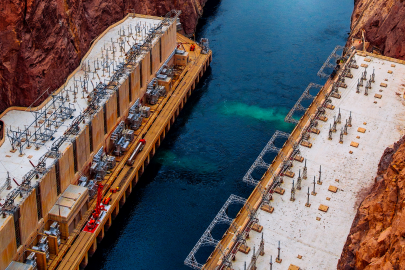WPTO Director Jennifer Garson discusses WPTO’s investments in efforts led by industry, academia, and our national laboratories to advance our understanding and development of water power systems and technologies.
Water Power Technologies Office
April 22, 2022Kelly Speakes-Backman, Principal Deputy Assistant Secretary for Energy Efficiency and Renewable Energy (EERE), has said “every day is Earth Day.” She’s right. At EERE, Earth Day isn’t just a day; it’s a commitment to clean energy and the environment that is a driving force in our individual careers and our collective work.
Here at the U.S. Department of Energy’s Water Power Technologies Office (WPTO), we’re invested in one of the Earth’s most bountiful and powerful elements: water. The climate emergency is threatening the health of our vast oceans and lively rivers. Their wellbeing—and that of the intricate web of life they support—are critical for the health of our planet and, of course, humans. It’s our obligation to help protect these waters, and we can—by harnessing their innate power.
That’s why WPTO invests in efforts led by industry, academia, and our national laboratories to advance our understanding and development of water power systems and technologies. Our partners perform work critical to realizing the full potential of water power and contribute to the Biden administration’s goals of a 100% carbon-free electric sector by 2035 and a net-zero-emissions economy by 2050.
WPTO’s investments are especially relevant this Earth Day and its “Invest in Our Planet” theme. Our ongoing work to accelerate the research, development, demonstration, and deployment of innovative water power technologies is an important investment in the planet and our clean energy future.
In our recent Semiannual Stakeholder Webinar, Kelly Speakes-Backman discussed the Bipartisan Infrastructure Law, which allocates nearly $1 billion for water power programs at the U.S. Department of Energy. There’s funding to modernize the hydropower fleet, the backbone of our future clean energy grid, and to advance technologies to mature marine energy, an abundant, untapped renewable energy resource.
This once-in-a-generation investment builds on and complements projects and other activities focused on building tomorrow’s clean energy grid.
Our partners are also working hard to monitor, protect, and preserve the wildlife and ecosystems that share space with water power technologies. For example, we’re focused on efforts that include:
- Monitoring and safeguarding marine wildlife. Through the Pacific Northwest National Laboratory’s Triton Initiative, we’re exploring ways to monitor potential underwater stressors—like noise—related to marine energy devices to ensure that when we do deploy these technologies, we have the tools and information needed to help protect marine species.
- Improving fish passage through hydropower facilities. Freshwater fish, like salmon, must migrate to find food and spawn. Through projects like HydroPASSAGE, we invest in information and tools that support the safe movement of fish through hydropower facilities.
We’re also working to better understand the impact of climate change on hydropower operations. This is critical for future operations and planning, but many smaller utilities may not have dedicated, in-house resources for modeling and evaluating climate risks. Earlier this month, we released a request for information that will ultimately help us design research and development initiatives, tools, and datasets that help address the risk of long-term climate change on hydropower generation.
There’s a lot of work to do to achieve our nation’s clean energy goals, and we can all play a part. At WPTO, we will do all we can to invest in a cleaner future for all Americans today and for many generations to come.
Learn more about WPTO projects that invest in our planet. Receive the latest information on WPTO funding opportunities, events, and other news by subscribing to the monthly Hydro Headlines and Water Column newsletters, as well as the comprehensive, bimonthly Water Wire newsletter.

Jennifer Garson

Jennifer is the Director of the Water Power Technologies Office at the U.S. Department of Energy, where she leads the office’s strategy, management, and execution of the $150M office. The Water Power Technologies Office advances research, development and demonstration of hydropower and marine renewable energy. For the last three years, she has led some of the office’s key activities and initiatives—like the Powering the Blue Economy initiative—and a portfolio of prizes, interagency grants, among other programs. She has focused on increasing the impact of federal funding for supporting innovation, including leveraging nontraditional financial mechanisms. This includes increasing the utilization of prizes, creative lab-directed funding, SBIR/STTRs, and other competitive solicitations. Over the last decade, she has worked across DOE, the federal government, and in partnership with the private sector to launch and create new programs, prizes, and commercialization approaches for blue economy and cleantech technologies and applications.
Prior to the Water Office, she was the Chief of Staff for the Deputy Assistant Secretary for Renewable Power in the Office of Energy Efficiency and Renewable Energy. She was previously a Senior Advisor for the U.S. Department of Energy Office of Technology Transitions, focused on Department-wide strategies for increasing the use of prizes, challenges, and other open innovation tools. She also focused on catalyzing new networks and prizes to help entrepreneurs move their technologies from research institutions into the market in the Office of Energy Efficiency and Renewable Energy Technology to Market team. Her programs supported hundreds of startups across the country through novel training programs, competitions targeted at university students, challenges linking solutions to major corporate partners, supporting early-stage pilots helping validate companies' technologies, and creating new national and regional networks.
She served as a policy and market analyst in the Office of the Chief Financial Officer, developed analysis and provided technical assistance for the Office of Electricity Delivery and Energy Reliability on their smart grid portfolio during the Recovery Act, and served as a research assistant for a private consulting company.
Jennifer earned her B.A. in Anthropology and Environmental Studies Concentration at Kenyon College and her Master of Public Policy at George Washington University.
Articles by Jennifer Garson
-
 This National Hydropower Day, explore ways WPTO is helping build cleaner communities and making important contributions toward the United States’ goals of achieving a carbon-free electricity sector by 2035 and net-zero-emissions economy by 2050.
This National Hydropower Day, explore ways WPTO is helping build cleaner communities and making important contributions toward the United States’ goals of achieving a carbon-free electricity sector by 2035 and net-zero-emissions economy by 2050. -
 WPTO Director Jennifer Garson discusses WPTO’s investments in efforts led by industry, academia, and our national laboratories to advance our understanding and development of water power systems and technologies.
WPTO Director Jennifer Garson discusses WPTO’s investments in efforts led by industry, academia, and our national laboratories to advance our understanding and development of water power systems and technologies. -
 Water Power Technologies Office (WPTO) Director Jennifer Garson presents the 2020-2021 WPTO Accomplishments Report, which highlights achievements from WPTO-supported research across its Hydropower and Marine Energy programs.
Water Power Technologies Office (WPTO) Director Jennifer Garson presents the 2020-2021 WPTO Accomplishments Report, which highlights achievements from WPTO-supported research across its Hydropower and Marine Energy programs. -
WPTO is working harder to protect, understand, and leverage the immense power and promise of the ocean.
-
The Cleantech University Prize Collegiate Competition has traveled coast-to-coast over the past four months to find America’s next clean energy entrepreneurs. Meet the teams that will compete for $100,000 in prizes at the National Competition this we...
-
Energy Department competition supports student entrepreneurs and helps spur development of new clean energy technologies.
-
The Cleantech University Prize recently made two stops along the Interstate 95 corridor, with regional competitions in New Jersey and Boston. With just two regional competitions remaining, Cleantech UP teams are inching closer to the national competiti...
-
Forty-two companies with promising energy and other cutting-edge technologies collected more than $1.69 million at the 2016 Rice Business Plan Competition in Houston, Texas, capping an annual event billed as the world’s richest and largest graduate-l...
-
NovoMoto, a student-led startup from the University of Wisconsin-Madison, took home $50,000 after winning the Energy Department's Cleantech University Prize regional competition at the annual Clean Energy Trust Challenge in Chicago. NovoMoto's MicroPla...
-
The Energy Department's Cleantech University Prize competition traveled to the campus of Carnegie Mellon University in Pittsburgh for the first-eve...
-
Heating and air conditioning -- an $11 billion industry in America -- accounts for 5% of domestic energy use.

